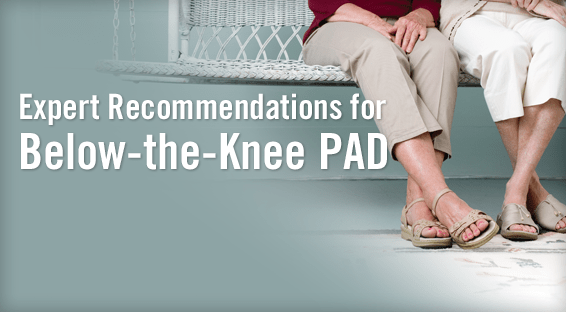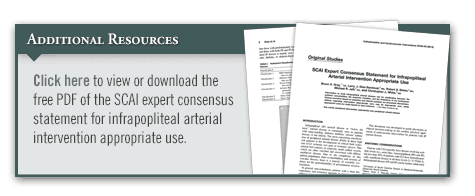Infrapopliteal (IP) arterial disease, also known as “below-the-knee” or tibial disease, is a condition commonly seen in the elderly or patients with long-standing diabetes or chronic kidney disease. One of the most concerning manifestations of peripheral arterial disease (PAD) in these high-risk patients is the development of critical limb ischemia (CLI), a painful and chronic condition that can lead to amputation. As the population ages and number of patients with diabetes rises, the rate of CLI is expected to increase. The incidence of obesity and diabetes is increasing, which in turn has increased the number of patients with PAD in the arteries of the limbs.
Oftentimes, the IP arterial bed is calcified and has diffuse, multilevel disease. “There is a paucity of scientific evidence for the generalizability of percutaneous revascularization in these patients,” explains Bruce H. Gray, DO, FSCAI. “This is due to the complexity of the patient population, their comorbidities, and the severity of vascular disease.”
In general, guidelines have recommended that non-ambulatory patients with a short life expectancy and extensive necrosis or gangrene undergo primary amputation. Surgical bypass can be considered for ambulatory patients who are acceptable candidates for surgery, which includes those who are expected to survive more than 2 years with a patent IP artery that provides direct flow to the foot and those with an adequate autologous venous conduit. Use of endovascular approaches should be considered first-line therapy for patients:
♦ With significant medical comorbidities that limit life expectancy.
♦ At increased risk for surgery.
♦ Without an adequate distal target for bypass.
♦ With poor venous conduit.
Coming to a Consensus
In 2014, the Society for Cardiovascular Angiography and Interventions (SCAI) released a document to guide clinical decision making in the application of newer endovascular interventions for patients with IP arterial disease. “Previous guidelines on how to manage patients with PAD have provided little guidance with regard to those with IP arterial disease,” says Dr. Gray, who served as lead author of the SCAI consensus paper. “Few data are available because the disease has been a moving target in terms of both the changing characteristics of patients developing IP arterial disease and treatment advances in the field.”
The SCAI expert consensus document, published in Catheterization & Cardiovascular Interventions, recommends that clinicians use the Rutherford classifications for PAD when determining the severity of CLI (Table 1). Patients with CLI typically have disease that involves multiple levels, such as the aorto-iliac arteries, the femoropopliteal arteries, and the IP arteries. The Rutherford classification system can help clinicians determine if patients are at higher risk for amputation.
Considering Treatment Options
Depending on each patient’s condition and their Rutherford classification for CLI, the SCAI consensus document focuses on the appropriate role of endovascular strategies for these patients. The expert panel reviewed data on different CLI treatment options, including balloon angioplasty, stents, atherectomy, and experimental therapies, such as drug-coated balloons. The document also provides scenarios for when certain treatments may be appropriate or are rarely appropriate (Table 2).
According to SCAI, patients with severe IP arterial disease, those with pain at rest, and those with minor or major tissue loss should be considered for revascularization. These procedures may include either surgery or endovascular treatment to prevent amputation or improve healing following an amputation. Currently, there is no evidence to support treatment in those with asymptomatic disease.
“Treating patients with IP arterial disease and CLI can relieve pain, heal ulcerations, preserve limbs, and improve quality of life and function, but it’s important to select treatments appropriately based on patient characteristics,” says Dr. Gray. “Multilevel disease is more common than isolated IP disease. As such, a systematic approach to achieve complete revascularization is necessary to optimize outcomes.”
More on the Horizon
The SCAI document on IP arterial interventions is one of a series of recommendation papers for treating PAD that has been recently released, with other topics including aorto-iliac arterial interventions, femoral-popliteal arterial interventions, and renal artery stenosis. “The SCAI consensus paper is subject to change as new data emerge, but it should be viewed as a springboard for future research,” Dr. Gray says. “There are many unanswered questions about the role of endovascular interventions for treating CLI in patients with IP atherosclerotic disease. We need to open the dialogue and generate discussion about how best to treat these patients, especially as new treatment modalities emerge. This will become increasingly important as we use patient-centric strategies that are also cost conscientious.”




 TimH
TimH